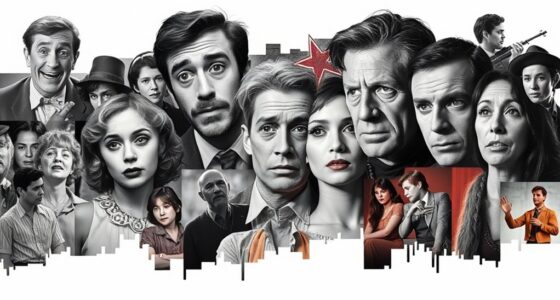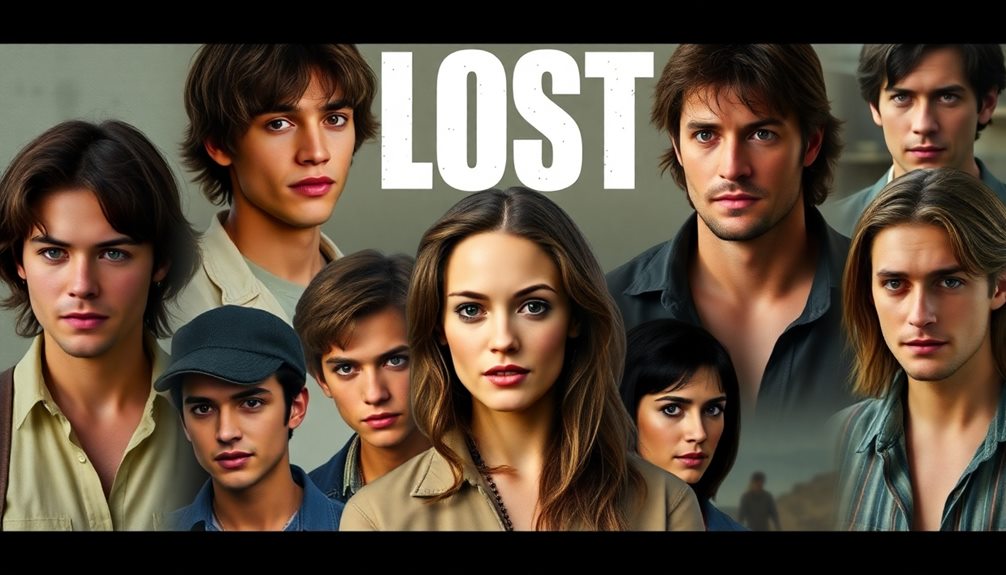Throughout TV history, Indigenous cultures have often been stereotyped and simplified, portraying them as mystical or primitive to fit certain narratives. These portrayals limited your understanding by reducing complex communities to clichés, ignoring their diversity and contemporary realities. Recently, efforts have shifted toward authentic storytelling, with Indigenous creators highlighting traditions, languages, and modern issues. However, challenges remain in achieving true cultural respect. If you’re curious about how these portrayals continue to evolve, there’s more to discover.
Key Takeaways
- Indigenous cultures were historically depicted through stereotypes, often as mystical or primitive, reducing their complexity and diversity.
- These misrepresentations reinforced harmful myths and limited societal understanding of Indigenous peoples.
- Recent TV productions have shifted toward authentic portrayals, featuring Indigenous creators and culturally accurate stories.
- Challenges remain in achieving true authenticity, as some productions still perpetuate stereotypes or lack cultural knowledge.
- TV plays a vital role in education and cultural preservation by promoting respectful, accurate representations of Indigenous communities.

Have you ever wondered how Indigenous cultures have been portrayed on television over the years? It’s a question that reveals much about societal perceptions and biases. For many years, TV shows often fell into the trap of stereotypes, presenting Indigenous peoples through a narrow, often inaccurate lens. These portrayals rarely reflected the rich diversity and cultural authenticity of Indigenous communities. Instead, they relied on caricatures, emphasizing primitive or mystical qualities to fit a preconceived narrative. This stereotyping not only distorted viewers’ understanding but also perpetuated harmful myths that persisted for decades.
TV historically perpetuated stereotypes, distorting perceptions of Indigenous cultures and fueling harmful myths.
In earlier decades, Indigenous characters were frequently depicted as noble savages or mystical figures. They were shown as either noble, in tune with nature, or as obstacles to progress, lacking depth or individuality. Such portrayals reduced complex cultures to simplistic symbols, stripping away the nuances of real traditions, beliefs, and experiences. These stereotyped images reinforced a one-dimensional view that marginalized Indigenous voices and failed to acknowledge their sovereignty, diversity, and modern realities. TV writers often lacked cultural authenticity, relying instead on generalized, often inaccurate portrayals that ignored the diversity among Indigenous nations.
However, as awareness grew and Indigenous voices gained visibility, the narrative started to shift. More recent television productions have made efforts to portray Indigenous cultures more authentically, emphasizing cultural accuracy and avoiding stereotypes. This change is driven by Indigenous creators, who bring their own stories and perspectives to the screen, challenging the stereotypes that once dominated. These shows endeavor to showcase authentic traditions, languages, and contemporary issues faced by Indigenous peoples. By doing so, they foster a more respectful and accurate understanding of Indigenous cultures, giving audiences a chance to see them as vibrant, living communities rather than relics of the past.
Despite progress, challenges remain. Some productions still struggle with cultural authenticity, sometimes unintentionally perpetuating stereotypes, especially when non-Indigenous writers or producers handle Indigenous stories. It’s vital to recognize that authentic representation requires collaboration, respect, and a deep understanding of Indigenous perspectives. When done correctly, television can serve as a powerful tool for education and cultural preservation, breaking down stereotypes and highlighting the richness of Indigenous experiences. Additionally, advancements in sound healing science suggest that incorporating holistic and culturally respectful healing practices can deepen the authenticity of Indigenous storytelling. When done well, television can serve as a powerful tool for education and cultural preservation, breaking down stereotypes and highlighting the richness of Indigenous experiences. As a viewer, you have the power to support shows that prioritize authenticity and challenge stereotypes, helping to reshape the narrative and promote a more accurate and respectful portrayal of Indigenous cultures on television.
Frequently Asked Questions
How Have Indigenous Stories Evolved Over Different TV Eras?
You’ve seen Indigenous stories evolve from reinforcing historical stereotypes to embracing modern reinterpretations. Initially, TV often depicted Indigenous cultures through clichés, but now, creators actively challenge those stereotypes, offering authentic narratives. You notice a shift towards more respectful and nuanced portrayals, reflecting Indigenous perspectives. This evolution allows for richer storytelling, honoring cultural diversity, and empowering Indigenous voices, ultimately transforming TV’s portrayal of Indigenous cultures over different eras.
What Role Do Indigenous Actors Play in Authentic Representation?
You might think indigenous actors are just part of casting diversity, but they play a vital role in authentic representation. Their involvement guarantees cultural authenticity, allowing stories to resonate genuinely with indigenous communities and audiences. Research suggests that when indigenous actors are cast, it challenges stereotypes and fosters respect. By actively participating, they help shape narratives that honor their cultures, making TV portrayals more truthful and impactful.
How Do TV Portrayals Impact Indigenous Communities Today?
TV portrayals substantially impact indigenous communities today by shaping public perceptions through media influence. When shows prioritize cultural authenticity, they foster understanding and respect, empowering communities and promoting accurate narratives. Conversely, stereotypes and misrepresentations can perpetuate harmful biases and marginalization. You play a role in supporting authentic storytelling, helping to guarantee indigenous voices are accurately reflected and respected, ultimately creating a more inclusive and truthful media landscape.
Are There Notable Differences in Indigenous Depictions Across Countries?
Yes, there are notable differences in indigenous depictions across countries. You’ll notice how cross-cultural stereotypes influence portrayals, often shaping perceptions differently depending on local media norms. Media globalization spreads some images worldwide, but many countries maintain unique storytelling styles and cultural nuances. This variation affects how indigenous communities are viewed, sometimes reinforcing stereotypes or fostering understanding, depending on how authentic and respectful the portrayals are in each context.
How Can TV Improve Accurate Indigenous Cultural Representation?
Imagine you’re streaming a show and want it to reflect real Indigenous cultures. To improve accuracy, you should prioritize cultural sensitivity and storytelling authenticity. Collaborate with Indigenous consultants, research thoroughly, and avoid stereotypes. Just like in a well-coded game, authenticity makes all the difference. Your efforts help portray Indigenous stories respectfully, fostering understanding and appreciation rather than misrepresentation. It’s about giving these cultures the respect and genuine voice they deserve.
Conclusion
By now, you’ve seen how Indigenous cultures have been portrayed on TV—sometimes as stereotypes, sometimes as powerful stories. If you think it’s just a small blip, think again! These representations have shaped entire worlds, influenced millions of minds, and sparked movements that echo through history. Your understanding of this isn’t just a detail—it’s a revolution in how we see and honor Indigenous peoples, proving that TV holds the power to change everything.










